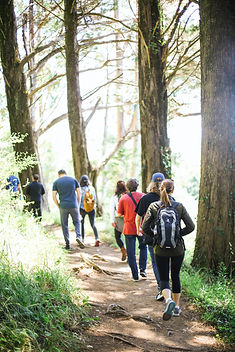
MOUNTAINEERING
What is mountaineering?
Rocky, jagged peaks. Snow covered mountain tops. Climbing on glaciers and reaching new summits. Reflecting on the adventure of getting up there. That’s mountaineering.
Scrambling vs. Mountaineering
Scrambling is hiking, but taken up a notch. It’s climbing over rocky, steep, rough terrain. It’s relying on your hands almost as much as your lower body to navigate a path. It’s taking your time to forge a path in sometimes unmarked terrain. Scrambling doesn’t really require any specialized gear. All you really need are some navigational skills and a hunger for hard work.
Mountaineering is all about the summit. It’s crossing crevasses, navigating glaciers, scrambling rocky terrain, and lots and lots of hard, physical work. Unlike scrambling, mountaineering requires technical gear and a solid understanding of how to use it. Climbing mountains is no easy feat, which makes reaching the summit that much more rewarding.
Who can do it?
If you’re a climber or hiker ready to forge ahead and (literally) reach new heights, you’re ready to start scrambling now.
If you’re an experienced hiker and are setting your sights on summiting some mountains, you’re ready to start your mountaineering journey.
Both scrambling and mountaineering are very physically challenging. In order to be safe and have a good time, you need to make sure your body is ready for the work to come. If you’re looking for a benchmark for your current physical fitness, take a hike up Mt. Si carrying 20% of your weight in a daypack. If you can make it within 2.5 hours with few rest breaks and without being exhausted, you’re ready for scrambling. If not, you’ve got a good goal to work towards.
How do I get started?
Ready to start your scrambling or mountaineering adventure? We’ve planned a skills progression course to get you out there summiting mountains by summer. Join us for all of our events, or just some. It’s up to you how you want to adventure.

Weekly Conditioning Hikes
Good for: Getting in shape for longer, harder, more demanding summits in Summer.
Come hike with us Tuesdays nights to get in shape for your summer adventures. We’ll hike to some of the high points in the I-90 corridor for a workout to help you reach your scrambling and mountaineering goals.
Interested? Check out our calendar.

Crevasse Rescue Course with Cascade Mountain Ascents
Good for: Getting hands on practice with glacier traveling and rescue
Crevasse rescue is a necessary skill for glacier travel at any level. Get your glacier climbing career started right with a comprehensive crevasse rescue course. Our two-day program efficiently teaches the necessary skills for dealing with various crevasse fall scenarios, without rushing through practice of these important tools.
This is a two day course with multiple dates.
Sign up for April 20-21, 2024
Sign up for May 4-5, 2024

Intro to Mountaineering Clinic with Mountain Bureau
Good for: Learning to travel safely over snow, using mountaineering gear, and basic mountaineering skills
This clinic is designed to introduce aspiring scramblers and mountaineers to the exciting world of Washington’s snow covered peaks. This program will give you the knowledge and techniques to ascend some of the PNW’s moderate summits.
Gear you’ll need
Scrambling Gear
The beauty of scrambling is that, at it’s core, it’s just a vigorous hike with a summit as the destination. Besides boots, a daypack, and the 10 essentials, there’s not much gear you’ll need on most scrambles. (Double check the trail reports. In some situations, specialty gear like crampons, ice axes or helmets might be necessary)
Mountaineering Packing List
Mountaineering takes special gear (as well as the skills to use them properly). Depending on the route, you might need to pack:
-
10 essentials
-
Helmet
-
Ice Axe
-
Crampons
-
Sunnies and Sunscreen
-
Backpacking gear
-
Meals and extra snacks
Need to rent gear? We’ve got you covered. Our gear is top-of-the-line so you stay safe and have fun while you’re out adventuring. Not sure what you’ll need? Visit our gear counter to chat with our friendly and knowledgeable staff.
Hone your Craft - Skills Progression
We’re so stoked to help you along your scrambling/mountaineering journey. We’ve created quite a few events to help you hone your skills and go from beginner to expert. You can see all upcoming events on our Gearhouse events calendar (pro-tip: filter by “Mountaineering/Scrambling” to find these events easily). Keep an eye out later in the season for more advanced events and adventures.
Wondering what kind of events you’re ready to join? Check out our list below. Remember to start with a skills check. If you can reach the top of Mt. Si in 2.5 hours without being exhausted, you’re ready to start your journey!
Beginner
You're an avid hiker or backpacker but are looking to go higher and harder. Join our weekly after-work conditioning hikes in the I-90 corridor to get your legs ready for steeper and more challenging days
Intermediate
You’ve taken our Intro to Mountaineering skills clinic, your legs can get you atop Mt. Si comfortably. Now you're ready to come on our easy scramble days offered in May, June, July, August, and September.
Advanced
You're feeling strong. You've been joining our easy scramble days. You're comfortable with long days, off-trail travel, route finding, and “scrambling” over 2nd & 3rd class terrain. Join our “hard” scramble days, May-September



